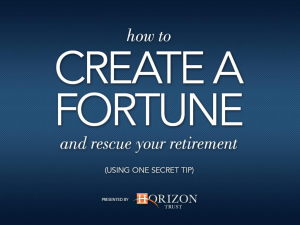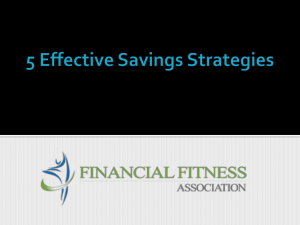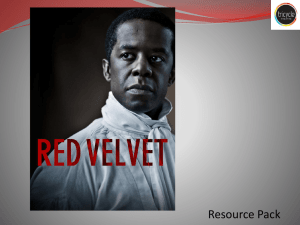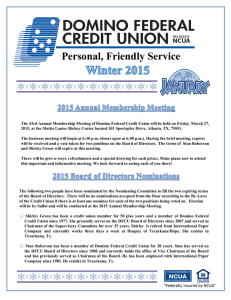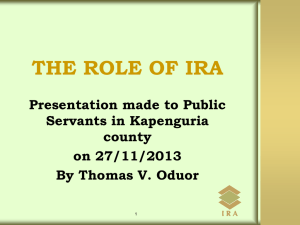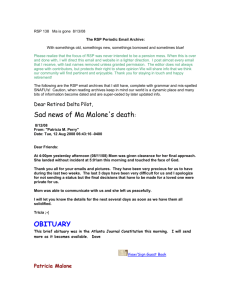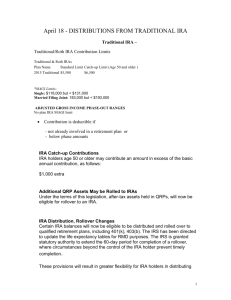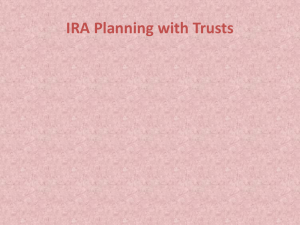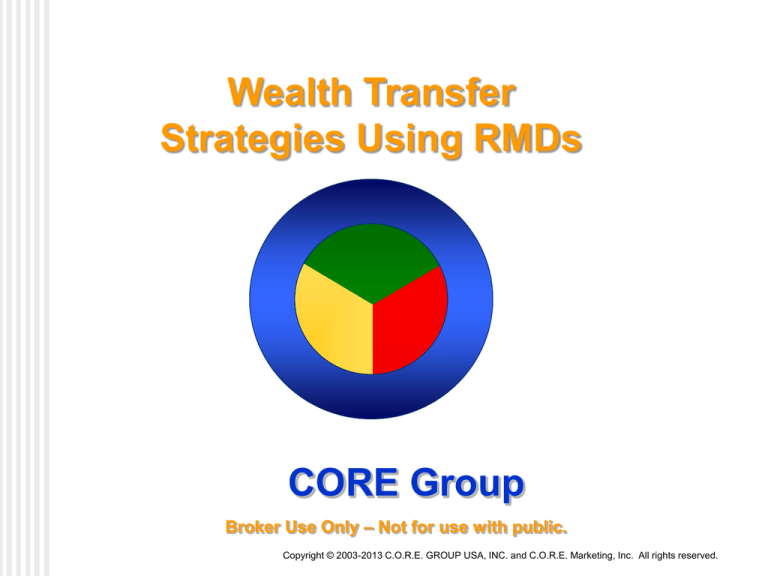
Wealth Transfer
Strategies Using RMDs
CORE Group
Broker Use Only – Not for use with public.
Copyright © 2003-2013 C.O.R.E. GROUP USA, INC. and C.O.R.E. Marketing, Inc. All rights reserved.
Getting the BEST Use of an IRA
Are you interested in getting the best
use of your IRAs?
$ Income
$ Children
$ Charities
$ Other
If you could do more….would you?
Why Target IRAs?
• Baby Boomers over the next 20 years will transfer
more wealth than this country has ever seen. Much of
it, $7 trillion to be exact, is accumulating in taxdeferred accounts like IRAs and 401(k)s.
• The key word here is tax-deferred, not tax free.
No matter what you do, either you or your heirs
will have to pay taxes on that money some day.
IRA Legacy Planning
While these qualified assets are accumulating
tax-deferred during your client’s lifetime, the tax
burden they are leaving their children is growing
as well.
Today we will introduce a simple wealth transfer
solutions specifically designed to alleviate the
tax burden on qualified accounts like IRAs and
401(k)s.
Offsetting Income Taxes
Summary:
• Your client has a significant amount of money in an IRA.
• He is taking RMDs, but he doesn't need them for income.
• He would like to leave the IRA to his beneficiaries, but
he's concerned about leaving them a large tax burden as
well.
In this concept, you take a portion of the unwanted RMDs
and use them to fund a life insurance policy that will help
offset the income taxes his beneficiaries will owe when the
IRA is transferred to them.
Assumptions
• Married couple
• Both age 70
• $1 million IRA in the husband’s name
• 6% growth rate on the IRA
• 28% tax rate for the couple and their heirs
• No withdrawals other than RMDs
Step #1
Determine the projected value of the IRA at a point in the future
when your client expects to transfer the IRA value to his heirs.
In this case, let’s say the client’s life expectancy is 80. You will
illustrate the IRA value at age 80 (taking into account the 6%
growth rate and the RMDs) to be $1,154,424.
Step #2
Estimate the income tax the beneficiary will owe if the IRA is
inherited as a lump sum when your client turns 80.
If your beneficiary inherits the IRA as a lump sum, income taxes
will be assessed on the entire amount.
Estimated
Value (age 80)
$1,154,424
Taxes owed
by
beneficiary
Estimated
Tax Rate
X
28%
=
$323,239
Step #3
Purchase life insurance
Use a portion of the client’s unwanted RMDs to fund a life
insurance policy with a face amount equal to the
beneficiary’s expected tax liability—in this case $323,239.
Annual life-pay premium to guarantee $325,000 in a
survivorship policy to age 120 is $6,741.
IRR
Results
• Beneficiary receives $1,154,424 inheritance from the IRA.
• Beneficiary receives $323,239 life insurance death benefit,
which is used to pay the tax liability owed on the IRA.
• The asset transfers, essentially, with no tax liability for the
beneficiary.
• And the life insurance didn’t cost your client anything
“out-of-pocket” because he simply leveraged the RMDS
he was taking anyway. Rather than putting them in the
bank, he simply committed a portion of them to paying his
life insurance premiums.
Other Strategies –
Use all of RMD
Client does not need any of his RMD for lifestyle
Take entire net of tax RMD and purchase as much life insurance
as it will buy to increase tax-advantaged wealth left to heirs.
Use a second-to-die policy to increase leverage.
Ideally use an ILIT to keep death benefit out of the estate.
Hopefully beneficiary will stretch the IRA to further enhance tax
advantages.
Other Strategies Charitable Planning
Use RMDs to buy life insurance – ideally death benefit should
exceed or equal projected value of IRA at death
Name a charity as beneficiary of the IRA.
At death, heirs receive the income-tax free death benefit that
replaces the IRA, and charity receives IRA.
Client’s estate is reduced by charitable gift of IRA.
Other Strategies –
Multi-Generational Planning
Client uses RMDs to purchase life insurance.
Client names grandchildren as beneficiaries of IRA so that longest
stretch period is achieved.
Client names children as beneficiaries of life insurance.
At death, children receive death benefit and grandchildren receive
IRA.
Other Strategies - Roth Planning
IRA
Owner withdraws
funds annually
from IRA to
purchase a life
insurance policy
on himself owned
by spouse.
Net IRA
At owner’s death,
insurance proceeds
are used to pay
income taxes on Roth
conversion.
At death spouse
converts to ROTH
At spouse’s death,
heirs inherit Roth
and receive lifetime
tax-free
distributions.
What Next?
•Identify clients with IRAs
•Identify clients who will not spend down their IRA
•Identify clients with desire to “do more”
•Call us with their information to discuss planning
strategies
By the Way
•Works for un needed social security income
•Same wealth maximization to family
•Fund a private social security program for family
•Multi generational financial security.
C.O.R.E. Group
Case Design
1.800.991.6695
casedesignteam@coregroupusa.com
C.O.R.E. GROUP USA, INC.
Centered on Relationship Enhancement
7373 N. Scottsdale Road
Suite A-287
Scottsdale, AZ 85253
480-991-4072 · 800-991-6695
Fax: 480-991-8885


